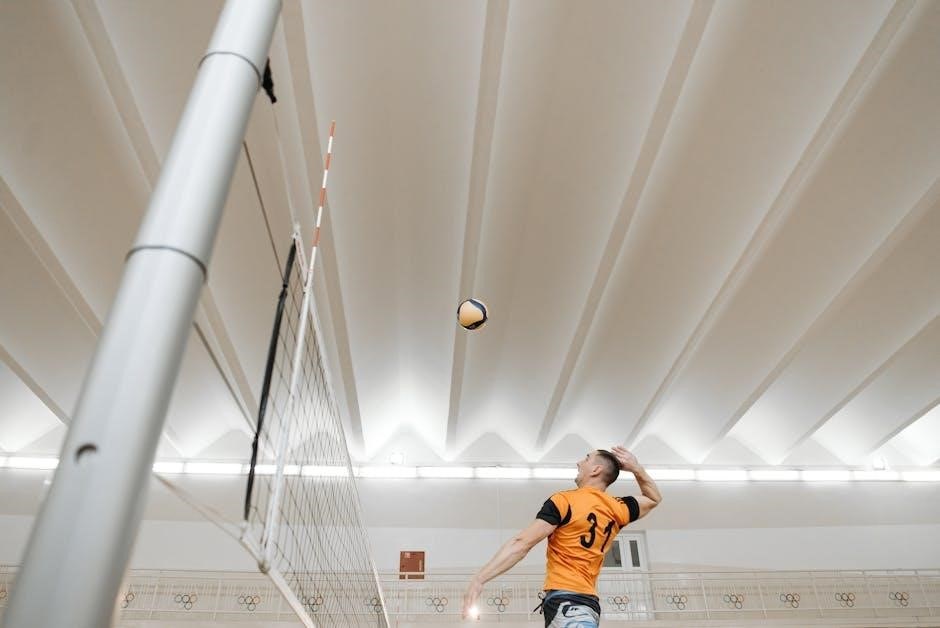The 7-day training program is designed to enhance volleyball performance through progressive skill development. It focuses on endurance, speed, agility, and injury prevention, ensuring a balanced approach to physical and technical growth.
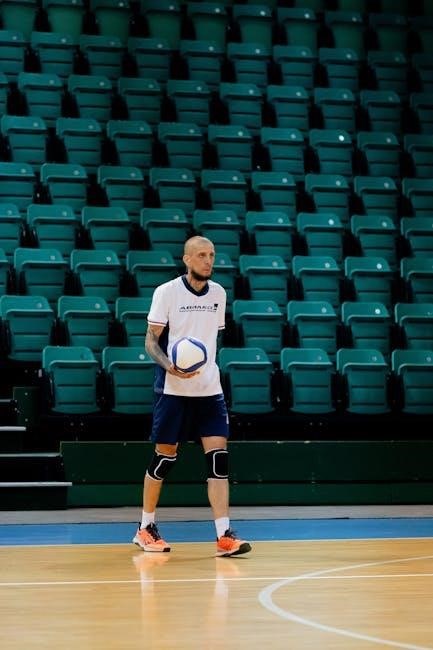
Overview of the Program
The 7-day volleyball training program is structured to progressively enhance technical, physical, and tactical abilities. Each day focuses on specific skills, such as foundational techniques, strength, agility, and game scenarios. The program integrates warm-ups, drills, and recovery strategies to ensure holistic development. It emphasizes endurance, speed, and injury prevention while providing a balanced approach to improve overall performance. This structured plan helps athletes track progress, stay motivated, and achieve peak readiness for competition.
Importance of Endurance, Speed, Agility, and Injury Prevention
Endurance is crucial for sustained performance throughout a match, while speed enables quick reactions and agility allows sharp directional changes. Injury prevention ensures long-term player health and consistency. These elements are interconnected, with endurance providing the stamina to maintain speed and agility over time. A well-structured 7-day program integrates exercises targeting these areas, ensuring players are physically prepared and resilient. This approach fosters overall athletic development, benefiting both novice and experienced athletes aiming to excel in volleyball.
Day 1: Foundational Skills and Warm-Up
Day 1 focuses on building core volleyball skills and preparing the body for the week ahead. It includes essential drills like passing, setting, and serving, combined with dynamic stretching to enhance flexibility and mobility. This foundational work sets the stage for advanced training in subsequent days.
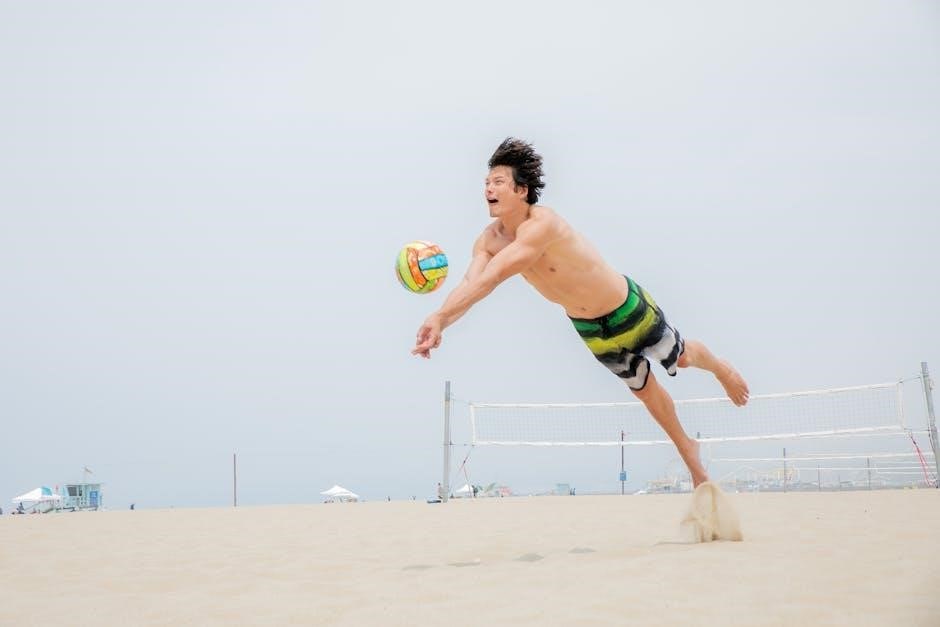
Passing Drills
Passing drills are fundamental to volleyball training, focusing on precise footwork, hand positioning, and core stability. Players practice receiving serves and hitting balls with controlled forearm passes. Emphasizing proper body alignment and quick reactions, these exercises improve accuracy and consistency. Drills include partner tosses, catch-and-pass sequences, and dynamic movement drills, ensuring players can handle various angles and speeds effectively. This skill is crucial for building a strong defensive foundation and seamless team transitions during matches. Regular practice enhances coordination and overall court performance.
Setting Techniques
Setting techniques are essential for controlling the ball and directing plays effectively. Proper hand placement, finger spread, and body positioning are emphasized to ensure precise ball control. Players learn to approach the ball with balanced footwork, using their wrists and forearms to guide it accurately. Drills focus on setting to different locations, such as outside, middle, and right-side positions, while maintaining consistent tempo and timing. Mastery of setting techniques enhances team coordination, enabling seamless transitions from defense to offense and creating scoring opportunities. Regular practice refines accuracy and confidence in setters.
Serving Fundamentals
Mastering serving fundamentals is crucial for consistent performance in volleyball. Proper foot positioning, hand contact, and arm swing are emphasized to generate power and accuracy. Players learn various serving techniques, including float and jump serves, to adapt to different game situations. Focus is placed on ball placement, spin control, and timing to disrupt opponents’ receptions. Drills include repetition of serves to target zones on the court, improving precision and versatility. A strong serve can significantly impact a team’s offensive strategy, making it a foundational skill in the training program. Regular practice builds confidence and enhances serving effectiveness.
Day 2: Lower Body Strength and Agility
Focus on building lower body strength and agility through exercises like squats, lunges, and agility ladder drills, enhancing power and quick movements essential for volleyball performance.
Squats and Lunges
Squats and lunges are foundational exercises for building lower body strength and explosiveness. Start with bodyweight squats, focusing on proper form, then progress to weighted variations. Lunges target balance and unilateral strength, essential for quick movements on the court. Perform 3 sets of 10-12 reps for each exercise. Incorporate variations like sumo squats or walking lunges to enhance agility and stability. These exercises improve power, stability, and coordination, crucial for volleyball-specific movements like jumping and rapid directional changes. Consistency and proper form are key to maximizing benefits while preventing injuries.
Agility Ladder Drills
Agility ladder drills are essential for improving foot speed, coordination, and reaction time. Start with basic drills like high knees, lateral shuffles, and carioca drills. Perform 3 sets of 10 reps for each exercise. Focus on quick, precise movements through the ladder, maintaining proper form. Gradually increase difficulty by adding complex patterns or reducing time per drill. These exercises enhance court movements, agility, and overall volleyball performance. Incorporate variations like alternating feet or backward movements to challenge coordination and balance. Consistency in these drills will improve explosiveness and reaction time during games;
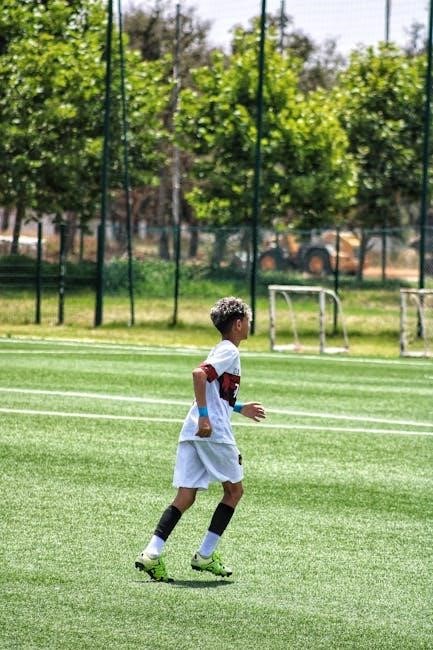
Jumping Exercises
Jumping exercises are crucial for developing explosive power, a key component in volleyball. Start with box jumps, focusing on exploding upward and landing softly. Perform 3 sets of 8 reps, aiming for higher boxes as you progress. Incorporate depth jumps to improve reactivity and power, jumping immediately after landing. Plyometric exercises like burpees and jump squats also enhance vertical leap. Consistency in these drills will increase your ability to spike and block effectively during games, giving you a competitive edge on the court. Proper form and recovery are essential to prevent injury.

Day 3: Upper Body Strength and Core Workout
Focus on building upper body strength and core stability through push-ups, pull-ups, shoulder exercises, and core-strengthening drills to enhance overall volleyball performance and endurance.
Push-Ups and Pull-Ups
Focus on building upper body strength with push-ups and pull-ups. Perform 3 sets of 10-12 reps for each exercise to enhance muscle endurance. Push-ups target the chest, shoulders, and triceps, while pull-ups improve lat strength and overall upper body power; Incorporate variations like wide-grip pull-ups for better shoulder stability. These exercises are essential for improving blocking, hitting, and overall volleyball performance. Ensure proper form to avoid injury and maximize results.
Shoulder Exercises
Strengthen your shoulders with exercises like lateral raises, front raises, and overhead presses. These movements target the deltoids and rotator cuff muscles, crucial for serving and spiking. Perform 3 sets of 12-15 reps, using light to moderate weights. Incorporate resistance bands for added flexibility. Proper shoulder stability enhances control and reduces injury risk, especially during overhead movements. Focus on controlled motions to maximize effectiveness and maintain proper form throughout each exercise. Strong shoulders are vital for power and precision in volleyball techniques.
Core Strengthening
Enhance your core stability with planks, crunches, and Russian twists. These exercises improve balance, power, and overall volleyball performance. Perform 3 sets of 15-20 reps for each exercise. Incorporate dynamic movements like bicycle crunches and leg raises to target obliques and lower abs. A strong core reduces injury risk and enhances explosive movements on the court. Focus on controlled breathing and proper form to maximize effectiveness. Strengthening your core is essential for maintaining stability during jumps and quick changes of direction, making it a cornerstone of volleyball training. Consistency is key to building a resilient and powerful core.
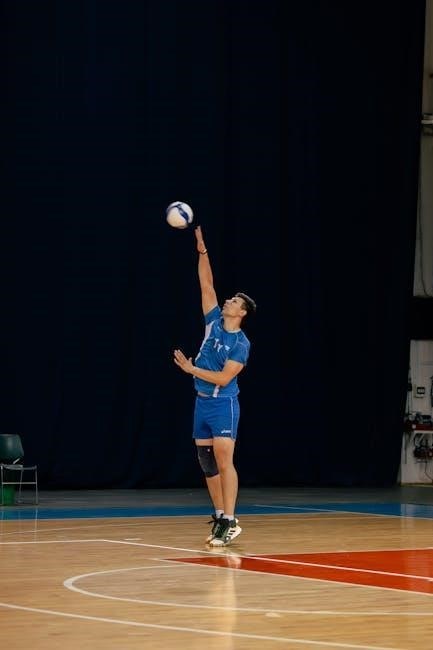
Day 4: Agility and Speed Training
Focus on shuttle runs, box jumps, and plyometric exercises to boost agility and speed. These drills enhance quick movements and explosive power, essential for volleyball performance.
Shuttle Runs
Shuttle runs are a key agility exercise in volleyball training. Players start at a designated point, sprint to a cone or marker, and quickly return. This back-and-forth movement mimics game scenarios, improving acceleration, deceleration, and reaction time. Proper footwork and technique are emphasized to maximize efficiency. Coaches often incorporate variations, such as changing distances or adding directional changes, to simulate match dynamics. Consistent practice enhances speed and agility, crucial for covering the court effectively during competition. These drills are essential for building the quick bursts of speed needed in volleyball.
Box Jumps
Box jumps are a plyometric exercise designed to improve explosive power and vertical jump. Players jump onto a box or platform, immediately stepping down to repeat the motion. This drill targets the legs, enhancing muscle activation and neuromuscular coordination. Proper technique ensures safety and maximizes benefits. Starting with lower heights and gradually increasing difficulty helps build strength and confidence. Box jumps are essential for volleyball, as they mimic the explosive movements needed for spikes and blocks. Consistent practice improves overall jumping ability, a critical skill for competitive play. This exercise is a cornerstone of the training program.
Plyometric Exercises
Plyometric exercises are high-intensity movements that enhance explosive power and speed. These drills, such as jump squats, burpees, and depth jumps, improve muscle activation and acceleration. They are essential for volleyball, as they mimic the explosive movements required for spikes, blocks, and quick reactions. Plyometrics increase vertical jump height and overall agility, giving players a competitive edge. Proper technique is crucial to maximize results and prevent injury. Incorporating plyometrics into the training program ensures players develop the power and speed needed for high-level performance on the court. Consistent practice yields significant improvements in athletic ability.

Day 5: Game Situation Drills
This day focuses on simulating real-game scenarios, helping players adapt to high-pressure situations. Drills emphasize applying strategies, improving decision-making, and executing plays under match-like conditions. Defense and offense are prioritized.
Simulating Game Scenarios
This session focuses on recreating real-game situations to enhance players’ adaptability under pressure. Drills include tiebreak scenarios, sudden-death plays, and high-stakes rallies. Players practice decision-making, quick reactions, and precise execution. Emphasis is placed on offensive and defensive strategies, ensuring teams can perform cohesively in critical moments. Communication and teamwork are highlighted to mirror actual competition dynamics. These drills build mental toughness and prepare athletes for the unpredictable nature of competitive volleyball; The goal is to improve situational awareness and confidence in high-pressure situations.
Tight Match Situations
This session trains players to excel in high-pressure, closely contested games. Drills mimic scenarios where the score is tied or time is limited, forcing quick decisions and precise execution. Athletes learn to maintain composure, communicate effectively, and capitalize on opportunities. Emphasis is placed on mental resilience, strategic plays, and adapting to the opponent’s tactics. These exercises prepare players to perform at their best when the game is on the line, fostering confidence and the ability to thrive in challenging moments.
Defensive and Offensive Strategies
This session focuses on mastering both defensive and offensive tactics to outpace opponents. Defensive strategies include perfecting stance, footwork, and blocking techniques, while offensive drills emphasize spiking, setting, and attacking combinations. Players learn to read opponents’ moves, anticipate plays, and execute precise actions. Emphasis is placed on teamwork, communication, and adapting strategies mid-game. These exercises help players control the tempo of the match, creating scoring opportunities while minimizing defensive vulnerabilities. The goal is to build a cohesive unit capable of executing complex plays under pressure.
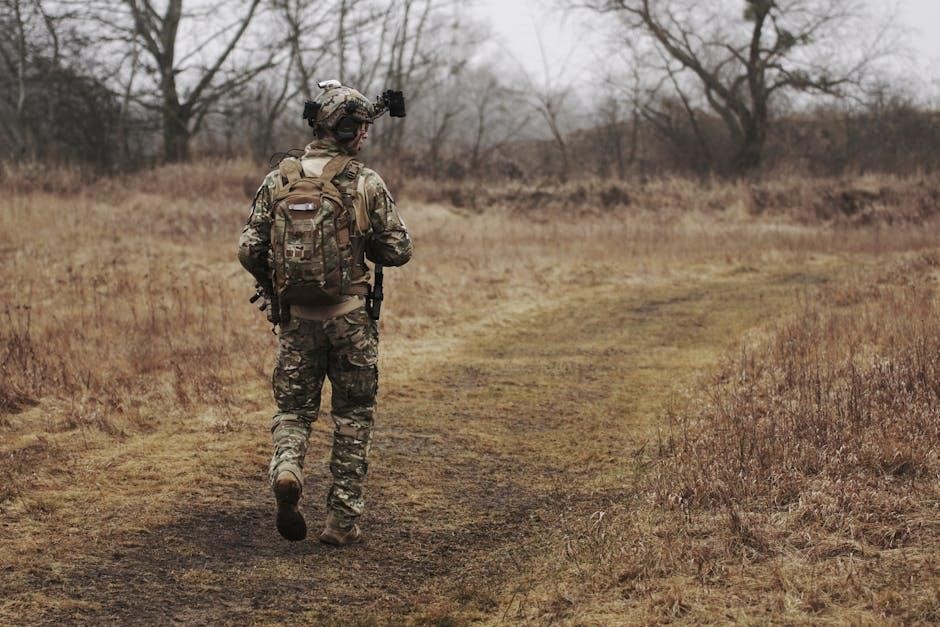
Day 6: Injury Prevention and Recovery
Focus on injury prevention with dynamic stretching, shoulder and knee stability exercises, and cool-down routines. Foam rolling and recovery techniques are emphasized to maintain flexibility and reduce muscle soreness.
Dynamic Stretching
Dynamic stretching is a key component of injury prevention, focusing on active movements that mimic volleyball actions. Players perform leg swings, arm circles, and torso twists to improve flexibility and range of motion. These exercises prepare muscles for intense activity by increasing blood flow and reducing stiffness. Proper form is emphasized to target specific muscle groups, ensuring optimal preparation for training. This approach reduces the risk of injury while enhancing overall athleticism and readiness for the demands of the game. Consistency is crucial for long-term benefits.
Shoulder and Knee Stability Exercises
Shoulder and knee stability exercises are essential for injury prevention and optimal performance. These exercises focus on strengthening the rotator cuff, scapular stabilizers, and knee ligaments. Players perform movements like shoulder Y-cuffs, lateral band walks, and single-leg balances to enhance proprioception and joint stability. Foam rolling and resistance bands are often used to target specific muscle groups. Consistent practice of these exercises reduces the risk of common volleyball injuries, such as shoulder impingements and knee sprains, while improving overall stability and athletic performance. Proper form and controlled movements are emphasized throughout.

Cool-Down and Foam Rolling
Cool-down and foam rolling are crucial for muscle recovery and injury prevention. After intense training, players perform light stretching to improve flexibility and circulation. Foam rolling targets areas like the IT band, quads, and hamstrings to release muscle tension. Gentle, controlled movements help reduce soreness and promote blood flow. This routine, lasting 5-10 minutes, ensures muscles recover efficiently, preparing the body for the next day’s challenges. Consistent foam rolling enhances overall mobility and minimizes the risk of overuse injuries, keeping players in optimal condition throughout the program. Proper technique is emphasized for maximum effectiveness.
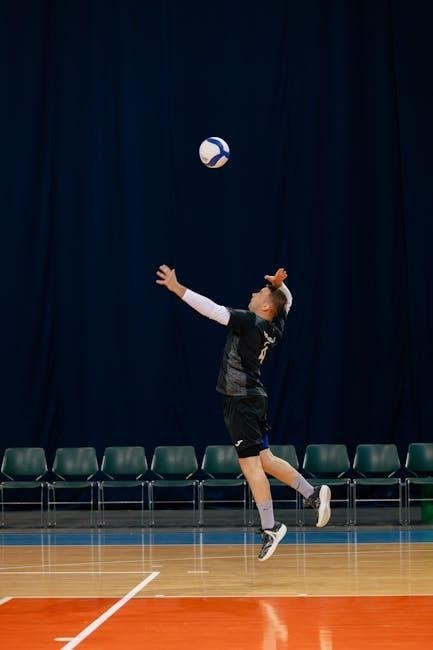
Day 7: Cool-Down and Skill Review
The final day focuses on light cardio, stretching, and reviewing key skills to reinforce techniques. Players reflect on progress, ensuring readiness for upcoming challenges.
Light Cardio and Stretching
This session begins with gentle exercises to gradually lower heart rates and improve flexibility. Jogging, jumping jacks, and dynamic stretches are ideal for loosening muscles. Players perform hamstring, quad, and hip flexor stretches to enhance range of motion. Arm circles and shoulder rolls are included to reduce tightness. The focus is on controlled movements to prevent muscle strain while promoting relaxation. Foam rolling is also introduced to aid in muscle recovery. This routine ensures players end the program feeling refreshed and prepared for future training. Proper form is emphasized throughout.
Review of Key Skills
This session focuses on refining foundational techniques to ensure mastery. Players revisit passing, setting, and serving with emphasis on proper form and consistency. Coaches provide feedback to correct errors and enhance precision. Drills include partner passing, controlled sets, and targeted serves. Agility and footwork exercises are incorporated to improve court movement. The review also covers offensive and defensive strategies, ensuring players understand game scenarios and decision-making. This structured approach reinforces learning, builds confidence, and prepares athletes for competitive play. The goal is to solidify skills and create a strong foundation for future training.
Nutrition and Recovery Tips
Proper nutrition and recovery are crucial for optimal performance. Athletes should focus on a balanced diet rich in lean proteins, complex carbs, and healthy fats to fuel workouts. Hydration is essential, with water intake recommended throughout the day. Post-workout meals should be consumed within 30-60 minutes to aid muscle recovery. Incorporate foods high in antioxidants to reduce inflammation. Ensure adequate sleep (7-9 hours) for physical and mental rejuvenation. Avoid processed foods and sugary drinks to maintain energy levels. Recovery techniques like foam rolling and stretching should be part of daily routines to prevent muscle soreness.
